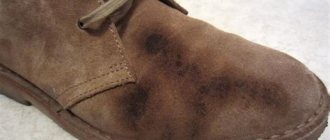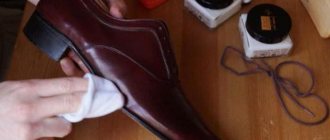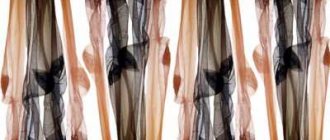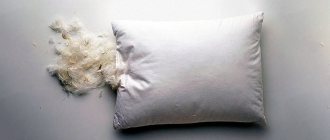Updated: 08.11.2021 15:21:17
Expert: Tatyana Hans
Sooner or later, owners of fur products come to the conclusion that things need cleaning. And here several questions arise - how to wash fur, is it possible to do this at all, can you use a washing machine for this or should you only use hand washing? Let's start with the fact that it is recommended to dry-clean expensive items made from natural or artificial materials; they should be processed only by professionals who have the skills, experience, specialized cleaning products and equipment. If you wash a fur coat, short fur coat, vest at home, they can become deformed and shrink. If it is not possible to dry-clean your item, you can try dry cleaning at home; later in the article we will dwell on this topic in more detail. Collars, removable cuffs, and natural fur trim can be washed by hand or in a washing machine. However, you must strictly observe the correct washing technique so as not to spoil the item. It’s better not to take risks and trust the professionals, but if you prefer to wash it yourself, we’ll tell you how to do it as safely as possible. Regarding faux fur products, they can be safely washed both in an automatic machine and by hand. Manufacturers of such clothing focus consumers’ attention on the fact that their products are machine washable.
How to wash real fur by hand
Experts once again warn: wash products made from natural fur only if you are confident in your abilities. So, the sequence of actions:
- We unfasten metal elements, decorative parts, inserts, and in general everything solid that can be removed from the object.
- We fill the washing container with warm water, dilute it with a specialized detergent for washing delicate fabrics, or better yet, baby shampoo, the best option is animal shampoo (veterinary). The latter remedy is best, since in theory it does not contain aggressive chemicals that have a negative effect on the fat protection; if it disappears, the base (the inner layer) will loosen, and the villi will begin to fall out. After pouring the shampoo, beat the foam with your hands.
- We immerse the thing in water. We don’t knead, we don’t squeeze, we just stroke the fur with light movements and wipe it in the direction of the growth of the pile.
- Gently comb the fur using a wide-toothed brush.
- We take out the product from the soapy water, take new water, add a few tablespoons of ordinary 9% vinegar to it. We immerse the item in water and let it sit for 2-3 minutes.
- Change the water again, this time pour cold water, since it is recommended to rinse at low temperatures, because cold water covers the hair scales, as a result, the fur will shine after drying. You need to rinse the product in as many changes of water as necessary so that the resulting water is completely transparent and without a hint of foam.
- Carefully squeeze the item with your hands, do not twist it.
It is recommended to dry natural fur on a flat surface, in a horizontal position, after laying a terry towel under it. Drying should take place in a ventilated room with well-circulated air, away from heat sources (including the use of a hair dryer to speed up drying). There should be no strong-smelling objects around, otherwise the smell may be absorbed into the fur. After the item is completely dry, carefully comb the lint, moving in the direction of its growth.
Is synthetic fiber washable?
Items with short and dense pile can be machine washed
How to wash faux fur without damaging the synthetic fibers? Items with short and dense pile can be machine washed. You can wash and clean synthetics at home in different ways. Much depends on the manufacturing technology of the items, the volume of the item and the nature of the contamination. For example, it makes no sense to wash a faux fur coat completely if a couple of drops of oil get on the sleeve or back.
During any method of processing fur products, the following rules should be observed:
- Synthetic pile tolerates high humidity, low temperature and drying with cold air without significant problems.
- Minimal damage will appear even with low heat in the form of dullness and hardness of the pile. You should always give preference to dry and wet cleaning. This is faster, safer and cleans the product no worse than classic washing.
- Dry cleaning can only be used after reading the instructions or label on the product.
- Do not dry near central heating radiators, on electric dryers or on a balcony under direct sunlight.
- Before using fur clothing, make sure it is completely dry. If the product is very disheveled and wrinkled, then it is smoothed with a damp hand and combed with a soft sponge.
- Fur garments may turn yellow or lose their whiteness due to improper washing. The use of aggressive detergents and bleaches also leads to disruption of the structure of synthetic materials and loss of consumer properties.
- The best way to preserve a fur coat and other items made of faux fur in its original form is periodic and timely cleaning, regular care and compliance with the storage conditions of the product.
- The best way to preserve a fur coat and other items made of faux fur in its original form is periodic and timely cleaning, regular care and compliance with the storage conditions of the product.
How to wash faux fur in a machine?
Timely cleaning and care prevents you from washing the product too often
Cleaning fur items in a washing machine is necessary in cases where a large surface of the product is contaminated, and is only possible with the recommendations and permission of the manufacturer. If there are no corresponding markings on the manufacturer's label, then it cannot be washed.
Do you wash faux fur in the washing machine?
Important: machine washing is best used for items with short and very dense pile. Otherwise, instead of a clean and noticeably refreshed item, you risk getting something dull, shaggy and very vaguely reminiscent of the previous product.
Before washing, you should carefully inspect the item for difficult stains, check pockets and the presence of decorative decorations. If there are old stains that have penetrated deeply into the material, they can be treated with oxygen bleach, soda or a solution of ammonia. When using bleach, first test the composition on a small area and see how the fur reacts to such a substance, only then apply to the dirty area. Read below about cleaning with natural absorbents.
The machine washing process in AFM will look like this:
- A fur coat, sheepskin coat or fur hat should be carefully turned inside out. If it is a collar on a down jacket, then you need to unfasten it from the item, or better yet, put it aside and clean it by hand.
- The product is placed in the washing machine. It is recommended to use only neutral or gentle powders in liquid form. You can use compositions for washing children's clothes.
- First, set the pre-soak mode for 15-20 minutes. If such a function is missing, then the item can be soaked in advance. To do this, use a small basin and cold water.
- After soaking, use the “rinse”, “gentle or delicate wash” mode. It is advisable to set the washing time to the minimum possible. It is better to turn off the spin and set it to the minimum number of revolutions.
- Once cleaning is complete, open the drum and allow the excess water to drain. You can take out the product and gently squeeze it with your hands in the bathroom or over the basin. Do not twist, squeeze or deform the fur under any circumstances.
Will spinning in the washing machine hurt?
Manufacturers in most cases do not prohibit spinning faux fur in the washing machine. However, this must be done using the minimum speed of the centrifuge, since high speeds can cause deformation and destruction of the base of the product, as a result of which the pile will come out.
How is it recommended to dry?
- We dry in natural conditions
- The optimal drying method is drying at room temperature or in the fresh air in cloudy weather.
- We spread it on a horizontal surface, preferably on a horizontal dryer for free access of air.
- If possible, dry in the open air; if this is not possible, then in a well-ventilated area.
- It is advisable to constantly shake the product while it is wet.
- It is not recommended to dry fur items in the sun and use heating devices and radiators.
- Most manufacturers prohibit drying clothes with faux fur in the washing machine on the dry setting.
- After complete drying, you can comb the pile with a massage comb.
Why does lint appear in the washing machine after washing?
- The wrong temperature setting was selected. Wash with cold water or at minimum temperature +40
- The pre-soak time has been exceeded. Over 15-20 minutes.
- Wrong washing mode selected. After soaking, you need to turn it on for rinsing, or set the minimum washing time.
- The thing was rubbing against the drum. You should use a bag for washing delicate laundry.
- Failure to maintain spin speed. No higher than 400 rpm. min.
- Wrong detergents have been selected. The “drying” mode was selected. Not recommended in an automatic car.
Fur hand washing process
Hand washing faux fur is more preferable, since it allows you not to wash the product completely, but to carry out only local cleaning or washing of a separate area. This is especially true for things with lush and long pile.
Before washing, as in the previous case, we inspect the fur for contamination. If the affected area is small, then it is better to perform local washing. For items that have not undergone any cleaning for a long time, washing with pre-soaking is better.
The sequence of hand washing is as follows:
- Local cleaning is performed using a soft sponge or cotton swabs. To do this, wet the stain or dirt with cold water. Next, apply detergent and gently foam. Then leave it for 2-3 minutes and remove it with a sponge. You can gently rinse the area from the shower.
- If a full wash is required, you will need to thoroughly clean the bathroom and fill it with some cold or cool water. First, a small amount of liquid is dissolved, and only then the product is immersed. Large items - a fur coat, sheepskin coat, faux fur blanket - can be soaked for 15-20 minutes.
- Next, you will need to wash all heavily soiled areas - cuffs, sleeves, and the area around the collar. This can only be done with your hands using a rinsing-like motion. That is, the fur cannot be rubbed or deformed too much. You just need to “fluff” it a little with your hand and let the soapy water rinse the pile.
- Use lukewarm water to rinse the detergent. Then rinse well in cold water until the water runs clear. It is more convenient to use a shower with a watering can.
To more effectively remove remaining water from a fur coat and other large items, you will need to take two large white terry towels. Next, you will need to place the product between the towels and lightly squeeze it with your hands. You can simply leave it in a horizontal position for 20 minutes.
Washing in a washing machine
Washing items made from natural fur in a washing machine is an even more risky undertaking than washing by hand. But if you decide to do this, there is nothing complicated in the procedure. We set the most delicate mode on the machine panel - for silk and wool or down products. Or you can simply set the temperature to 30-40 degrees, the processing time is 30 minutes, without spinning, or with an additional rinse. We place the product in a special mesh or fabric bag made of white cotton fabric, load it into the machine (we do not wash any other things at the same time as fur). After completing the process, wring out the product, straighten it, and let it dry on a terry towel.
Machine washable
Only items with short and thick fur are suitable for washing in a machine, then it will not get tangled. Do not rush to turn on the delicate mode - the product cannot be washed. If this is a front-loading washing machine, then only the soaking mode will do, and “vertical” machines need to be filled with water up to half the drum.
Let the item sit in soapy water for about half an hour, after which you can start rinsing. If possible, it should be delicate, but many washing machines do not have such a mode. Then it's better to do it manually.
Do not leave the fur in water for a long time, otherwise the fabric base may become very wet, and the pile will deteriorate from the large amount of moisture!
You can't squeeze the item too hard. Hang it on a hanger above the bathtub or basin - the water will drain by itself. If this is a bulky blanket, then it is better to use a stick for drying; the clothesline can break from the heavy weight.
Features of washing products made from different types of natural fur
Let's look at how to wash or clean clothes made from the fur of different animals. Features of the procedure:
- Rabbit
. Before washing, be sure to ensure that the product is in good condition and will withstand the cleaning procedure. To do this, hold a small tuft of wool in your fingers and pull it slightly. If there are a lot of hairs left in your hands, it means that you cannot wash the product yourself; it is better to take it to professionals. Otherwise everything is standard.
- Arctic fox
. It is strictly not recommended to wash such products either in a machine or by hand. The inside of the item should not get wet. It may come into slight contact with water, but significant moisture ingress into the area near the roots of the villi and on the inside of the product is detrimental to it. Therefore, in order to somehow clean the product, restore shine and volume, you can carry out dry or wet cleaning. Dry is done using talc or crushed stationery chalk. The product is laid out, sprinkled with absorbent, it needs to be washed, then shaken and combed with a brush. To obtain the desired result, you may have to repeat the procedure up to 3-4 times. Wet cleaning is carried out using plain water, water and ammonia, water and shampoo. Pour any of the listed mixtures into a bottle with a spray bottle, spray the product onto the fur so that it becomes damp, but not wet, wipe the pile with a cotton or gauze swab. After this, you can take new tampons, moisten them with clean, cool water and wipe until completely free of detergent.
- Raccoon.
This fur, like arctic fox fur, is extremely demanding to care for and incredibly difficult to clean. It must be cleaned dry using grated chalk or talc. You can also wipe it with a damp swab, but only on the tops. During the cleaning procedure and during the drying process, raccoon fur must be constantly combed using a stiff brush with metal teeth, since the density of raccoon hair is increased.
- Fox.
Experts also do not recommend washing products made from the fur of this animal, since moisture should not get on the inside. Acceptable cleaning methods are dry and wet, by wiping the fur with a solution of water and animal shampoo.
Detergent
Can faux fur be washed? Can. Such a product can be processed manually, cleaned using home or professional products.
It is better to use specially formulated chemical products designed to remove dirt from artificial pile.
Manufacturers of such products recommend using the following products:
- FLAT;
- VESTAR (washing gel);
- Emsal Tuba;
- Alles Gut;
- Dreft Delicates&Color;
- Luxus Professional;
- Frosch.
All detergents will provide a delicate wash, show good results, retain the shape of the product and protect the color from fading.
Dry cleaning method
Obviously, most fur items are not washable in the classical sense of the word. And if some things can be washed, then this should be done by professionals; home processing can lead to damage to the product. However, you can clean your clothes using dry or semi-dry cleaning methods. We already wrote above that for this you can use chalk and talc, dog shampoo diluted in water. Let's consider what other means can be used for such purposes. But first, a piece of advice - before you start cleaning, shake the product thoroughly, knock the dust out of it, and vacuum it using a special attachment for upholstered furniture.
Additional products for dry and semi-dry cleaning of fur items
(it is better to carry out the procedure in the fresh air or in the bathroom, so that you do not have to do a general cleaning of the room later):
- Flour.
- Oatmeal ground in a blender or coffee grinder or meat grinder.
- Water with hydrogen peroxide.
- Sand.
- Starch.
- Small sawdust.
Keep in mind that food products (flour, oatmeal, etc.) used during cleaning may attract the attention of insects, in particular moths. If you do not completely remove such an improvised cleaning agent from the pile, insects can damage both the interior and the pile.
Preparing for washing
In order not to spoil the product and decide whether to wash it by hand or in a machine, you need to familiarize yourself with several rules. They will allow you to carry out the procedure carefully and not spoil the item.
- Do not wash fur in hot water. The base on which the pile rests can become loose, causing the fur to fall out and create gaps. For the fibers themselves, high temperature is also not beneficial, because after such washing they become less smooth and shiny.
- If you decide to take your fur coat or blanket to the dry cleaner, find out in advance whether they have special equipment for cleaning faux fur items. If you don't worry about this, you can get results equal to washing at home.
- Unlike natural fur, artificial fur does not have a direction for hair growth, so it is difficult for the pile to return to its original state after wet processing. You can help him by smoothing his fur when wet with your hand, and when it dries, comb it.
- Do not hang wet items to dry near heaters or in direct sunlight. This can ruin the structure of the hairs - they will curl and wrinkle from the high temperature.
- White fur requires special treatment, because its pile can become darker if washed incorrectly. It is possible to correct this, but achieving the initial shade will be almost impossible.
How to clean natural fur from yellowness
Over time, the fur on the product may turn yellow. This does not make the item more attractive, so many owners of fur clothing try to return the pile to its natural color. This can be done using a product that is prepared according to a simple recipe - mix one tablespoon of ordinary table salt and half a tablespoon of ammonia in half a glass of water (we work in a respirator so that the smell of ammonia does not irritate). Then take a soft cloth, preferably white cotton, dip it in the solution and wring it well, it should remain barely damp. We wipe the fur with a cloth, especially carefully treating the yellowed areas. This way we remove greasy contaminants that give the fur an unsightly tint. After this, shake the fur product, straighten the fibers, and leave to dry.
Tips from the experts
Experts in the field of caring for fur products give several recommendations that will help you carry out the cleaning procedure effectively and safely:
- Never use dry washing powders for washing. It is also prohibited to use any household or homemade stain removers or bleaches.
- Never twist wet fur items, as this will harm both the fur and the lint.
- Fur should not be dried in direct sunlight or near heating appliances.
Well, the last recommendation is that fur should never be ironed, even from the inside out, so you should not do this either.
How to wash faux fur items
Products made from synthetic fur are hand washed in the same way as items made from natural materials. Machine washing on a delicate cycle is also allowed, but only if the length of the pile does not exceed three to four centimeters. You can dry clothes in the standard way - on a horizontal surface, on a terry towel, in a well-ventilated room.
Traditional methods
All these methods have been successfully tried by many women; they help clean fur without contact with water, without spoiling it. Some methods will require time and patience, but the results are worth it.
You can use flour, but not traditional wheat, but rye or oatmeal. Oatmeal crushed in a blender or coffee grinder will also work.
- It is necessary to pour flour into a large basin so that it occupies 1/3 of the space.
- Place the contaminated item in a basin and roll it in flour on all sides.
- You should act energetically, so it would be better to carry out the procedure in the bathroom.
- Shake the flour off the product.
- Vacuum any remaining flour using a furniture attachment.
- Hang the fur coat on a hanger in the closet for a day.
- Comb the product, removing any remaining flour.
Hydrogen peroxide
For items where dirt is most visible, you can use a delicate cleaning method. This algorithm was created specifically for a white or light fur coat, the material of which is mink or arctic fox.
- Soak a cotton swab in hydrogen peroxide.
- Moisten the teeth of a plastic comb with a cotton swab.
- Comb the item well.
- Walk a cotton swab soaked in hydrogen peroxide over the entire surface of the product.
- Allow the product to dry and comb it again.
This method allows you to remove not only dirt, but also the yellowness that appears over time.
Petrol
Cleaning of silver fox products should be carried out in an open space so that the living space is not saturated with the smell of gasoline. It is best to use a coffee grinder to grind bran.
- Mix crushed oat or rye bran with a small amount of gasoline. Instead of bran, you can use small sawdust.
- Hang the item on a hanger, and hang the hanger on the crossbar.
- Using rubber gloved hands, apply the mixture to clothing.
- Comb the product well and air it for an hour or two until the smell disappears.
Sand
It is best to use this method on fur products with a minimum number of seams, since sand can get stuck in them and is not easy to get out. This method is best for cleaning bedspreads, blankets, fur capes and stoles.
Heat a thick cast iron skillet.
- Pass river sand through a sieve and pour into a frying pan.
- Heat the sand until hot, but so that the temperature is tolerable for the hands.
- Spread the item on a flat, flat surface and sprinkle it evenly with sand.
- Gently rub the sand into the pile, removing dirt.
Color protection
To clean sheepskin, you can use a delicate method, which will take some time, but the product will definitely not deteriorate or lose its original color. This method is also very good for rabbit items.
- Take a special comb with rounded teeth for cleaning fur.
- On each clove, wrap a piece of cotton wool soaked in alcohol or kerosene or in a warm soap solution.
- Secure the cotton pieces with a cotton thread at each clove.
- Comb the fur along the hairline.
- Hang the product outside or on the balcony until the characteristic unpleasant odors disappear.
When is the best time to turn to professionals?
Of course, experts recommend going to dry cleaning whenever you need to wash or otherwise clean a product made from natural fur, especially such expensive types as arctic fox and mink. But if your clothes become heavily soiled, you definitely cannot do without the services of professional dry cleaners. When to call a specialist:
- If there are dirty stains on the clothes from precipitation (snow, rain).
- If there are traces of reactive salts on the product, especially on the hem, which utility workers sprinkle on roads and sidewalks in the winter.
- If there are stains of unknown origin, traces of cosmetics and other foreign substances on things.
- If the product is heavily soiled, it is impossible to clean it yourself at home.
Experts advise dry cleaning fur clothes at least once a year, the optimal time being spring. Professional cleaning will not only return the product to its aesthetic and attractive appearance, but will also prevent the occurrence of moths, which, as we know, can easily ruin the most expensive fur product. The cost of dry cleaning items made from natural or artificial material depends on several factors, in particular, the location of the company, its reputation, the length of the item and the complexity of its cut; on average, it is approximately 5,000 rubles. But, you must admit, a fur coat or other product costs much more, it is better to pay for professional care than to spoil the item and face the need to buy a new one.
Whitening
Over time, light-colored fur items may become unpleasantly yellow. You can take these items to the dry cleaner or use at-home bleaching methods:
- Potato starch or talc is poured over the entire surface of the fur coat for half an hour. The product is first laid out to evenly apply the powder. After time, the fur coat is shaken out and combed.
- A solution of table vinegar and citric acid is applied to the wool using a cotton pad. To distribute the active components throughout the pile, it is combed and left to dry.
- An aqueous solution of hydrogen peroxide and ammonia (a few drops per glass of water) is applied using a spray gun and the pile is treated with a brush.
- Crushed to a powder, a piece of chalk is poured onto the yellowed areas for thirty minutes. Next, shake the fur coat to remove any residue.
With the help of quite affordable means, you can restore the cleanliness and freshness of fur items. It is preferable to entrust the removal of heavy or large-area stains on expensive products to specialists.











